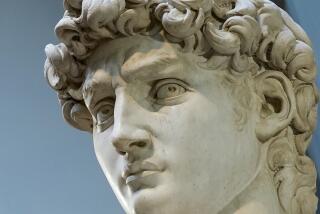Artistic riches get lost in the crowd
PISA, ITALY — Francesco Ra is the Maytag repairman of Italian tourism.
He is the guard and greeter at the least-visited museum in all of Italy: the National Royal Palace Museum of Pisa. Days, sometimes weeks, go by without seeing a single art lover or curious tourist.
“I read a lot,” Ra said. When a reporter wandered by, he practically snapped to attention, eagerly offering the guest sign-in book, with its many blank pages.
The image of Italy as a crowded mecca for tourists, with miles-long waits outside the Vatican and the Colosseum, and cheek-to-jowl crowds along Venice’s canals and in Florence’s Piazza della Signoria, is an accurate one. Italy, a nation of bountiful artistic riches, is overrun with visitors seemingly year-round.
But not every jewel gets the same attention. Federculture, a national organization that offers management advice to Italy’s network of about 4,000 museums, last month published a ranking of the country’s 15 least-frequented attractions, part of a campaign to urge the state to take better advantage of its cultural resources.
The top two sites (or bottom two, actually) were archaeological parks in the somewhat remote region of Puglia. One site, Siponto, with its ancient Greek ruins, receives four visitors a year. Pisa’s National Royal Palace Museum, featuring works by Raphael and Bronzino, was the lowest-ranking museum on the list, with just 299 visitors a year.
Given that the Leaning Tower of Pisa is but a few blocks away, and gets approximately 2.2 million visitors a year, the museum definitely has a problem.
“The whole world comes to Pisa for one thing only: the tower,” museum official Loredana Brancaccio said. The hordes arrive at the tilted wonder, jump from their buses, snap their photos and leave town. “They’re the bite-and-run tourists,” she said.
The disparity between the very visited and the lonely lose-outs develops because there are simply so many things to see in Italy, and because the state has failed to better package and promote what it has, said Giorgio Van Straten, a curator and head of Federculture.
Van Straten said Italy could do better for its patrimony if it coordinated management of sites across the country, sold more “multiple” tickets that grouped museums together for visitors and generally made museums and other sites more tourist-friendly.
“There is no capacity for developing an integrated project,” he said in a telephone interview from Florence. “Everyone just cares about their own backyard, or their own bell tower.”
Until recently, Van Straten noted, many museum directors viewed visitors as a disturbance or distraction. Bookshops and cafes at museums were frowned upon.
The Pisa museum seems caught in a spiral of decline. As the number of visitors drops, the state has slashed its budget every year, making it difficult to hire cleaners and guards and pay the electricity bill, museum director Mariagiulia Burresi said.
Truth be told, the place is a bit musty and dark.
Many days, it simply doesn’t open; even were a tourist to arrive, he or she might be turned away. (Call ahead to ask if they’re open and the answer is likely to be, “It depends . . .”)
The museum is in a rambling 16th century palace that served three royal households: the Medici, Lorraine and Savoy. It sits amid medieval towers and buildings and faces the picturesque Arno River. Most of the foot traffic on a recent day consisted of sun-pinkened German tourists making a beeline to photograph the river, seemingly oblivious to the works of art they were bypassing.
In addition to the commissions of generations of royal families, the museum has exhibited important works rescued from Pisa’s Civic Museum, which was destroyed by Allied bombing during World War II. Closing it down altogether, Burresi said, “would represent a great pain for me and for the city.”
But experts say it may be inevitable that smaller or less significant museums are shuttered or restricted to appointment-only tours by scholars.
“Italy is so rich,” Van Straten said, “that even beautiful sites can go unnoticed.”
--
Special correspondent Livia Borghese contributed to this report.
More to Read
Sign up for The Wild
We’ll help you find the best places to hike, bike and run, as well as the perfect silent spots for meditation and yoga.
You may occasionally receive promotional content from the Los Angeles Times.







